
Birding Around Las Vegas, Mount Charleston Area

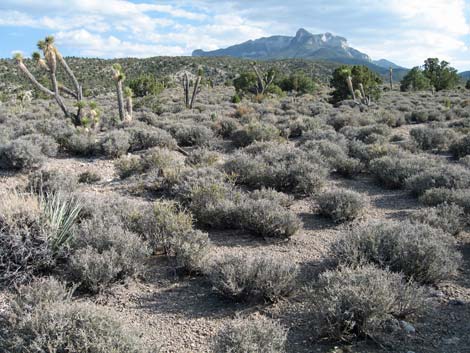 Pullout in the upper Mojave Desert Scrub zone |
Overview Lee Canyon is a good place to bird the western montane forest. The Lee Canyon Road starts in typical Mojave Desert scrub at an elevation of about 3,000 feet and climbs through the Pinyon-Juniper Woodland to a Yellow Pine Forest and then a Pine-Fir Forest mixed with Quaking Aspen and Bristlecone Pine at an elevation of about 8,700 feet, providing a good range of habitats, each with different species of birds and other wildlife. There are no particular birding "hot spots" in Lee Canyon, but there are many places to stop, enjoy the mountain habitat, and watch a few birds. Check the middle-elevation shrubland, bird from the road and picnic area, lounge in a meadow, take a hike, or climb to the summits -- there are plenty of opportunities to find good birds in Lee Canyon. |
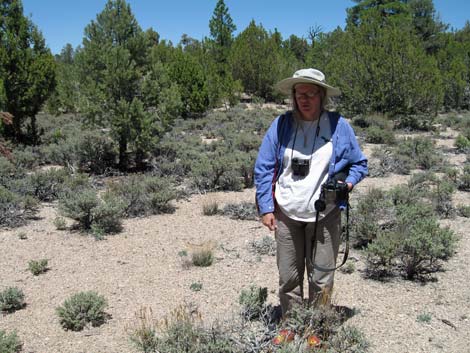 Pullout in the Pinyon-Juniper Woodland zone |
Description The Spring Mountains, located northwest of town, rise from desert valleys at elevations below 2,000 ft to the summit of Mount Charleston at nearly 12,000 ft. The great range in elevation creates a great range of climate and several vegetation zones. The Spring Mountains are completely surrounded by desert, forming an island of montane habitat surrounded by a sea of desert scrub. This island of high-elevation vegetation provides habitat for montane species not found in the deserts around Las Vegas. In contrast to the desert, the mountains have a real winter, and the changing seasons and winter snowfall results in a range of birding opportunities. Lee Canyon is one of the major canyons on the east side of Mount Charleston, and the Lee Canyon Road provides easy access to a number of hiking and birding sites, but there are no particular hot spots for birds. The best way to bird the area is to drive the road, stopping to bird in different habitat types (be sure to pull off the road and watch the traffic), and walking the trails along the road. |
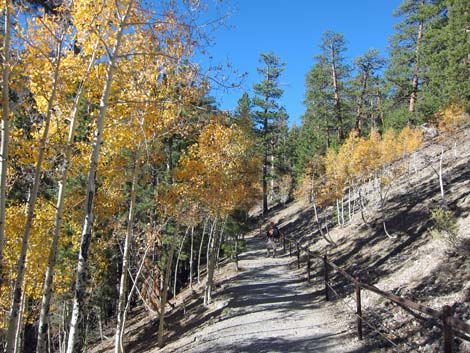 Quaking Aspen and pines along the Bristlecone Trail |
Lee Canyon Road starts in typical Mojave Desert Scrub, climbs through a scrub-oak canyon into the Pinyon-Juniper Woodlands, traverses a narrow band of Yellow Pine Forest, and gets to the Pine-Fir Forest mixed with quaking aspen and bristlecone pine at elevations near 8,700 feet. The end of the road is past the ski resort, high in the canyon surrounded by towering limestone cliffs and mountain ridges. Places to bird in Lee Canyon include pullouts along the road in the Mojave Desert Scrub desert and Pinyon-Juniper Woodland zones, the long meadow in the Yellow Pine Forest zone, the Pine-Fir Forest at the end of the road, and the Bristlecone Pine Forest along trails in the upper canyon. |
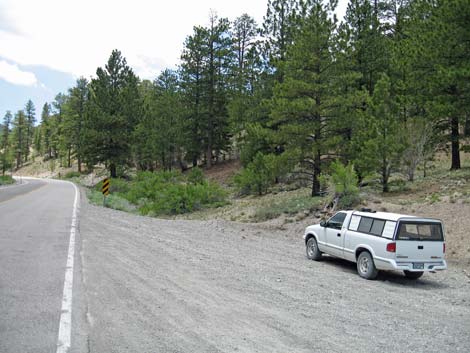 Pullout in the Yellow Pine Forest zone |
Pullouts along the Road There are a number of dirt and paved pullouts along the road to stop, pull completely off the road, and watch and listen for birds. In the desert zone, look for House Finch, Rock Wren, Say's Phoebe, and Red-tailed Hawk. In the pinyon-juniper zone, look for Juniper Titmouse, Pinyon Jay, Spotted Towhee, and Blue-gray Gnatcatcher. In the pine zone, look for White-breasted Nuthatch, Woodhouse's Scrub-Jay, Western Tanager, Yellow-rumped Warbler, Chipping Sparrow, and Dark-eyed Junco. |
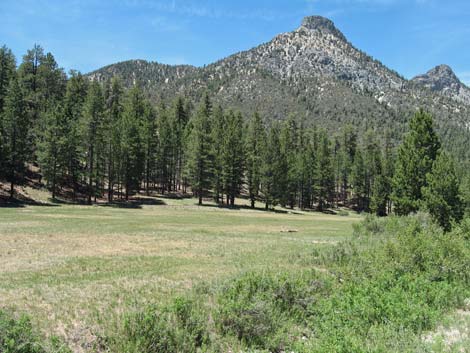 Lee Canyon Meadow in the Pine-Fir Forest zone |
Long (Lee) Meadow Long Meadow (Yellow Pine Forest zone) can provide good birding if there aren't too many people picnicking. Look for Western Bluebird, Mountain Bluebird, Cassin's Finch, White-breasted Nuthatch, Woodhouse's Scrub-Jay, Western Tanager, Yellow-rumped Warbler, Chipping Sparrow, and Dark-eyed Junco. This area can be busy on weekends, so a short walk in the woods might be a quieter choice. |
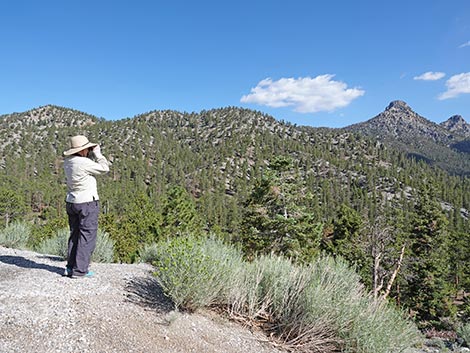 Birding the helicopter landing pad |
End of the Pavement The end of the road (far end of the ski area parking lot) gives treetop views of the canyon and is a good place to look down on birds. Look for Red-breasted Nuthatch, Pygmy Nuthatch, Steller's Jay, Lewis's Woodpecker, Western Bluebird, Mountain Chickadee, Cassin's Finch, Yellow-rumped Warbler, Dark-eyed Junco, and Clark's Nutcracker. |
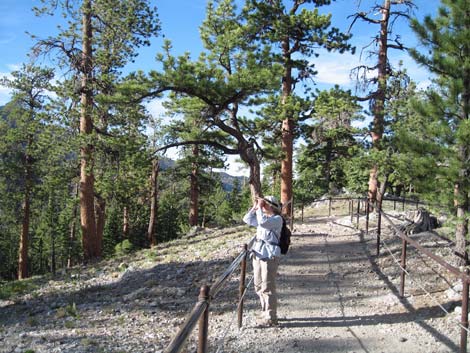 Bristlecone Trail with fence to protect rare plants |
Bristlecone Trail and the High Country The upper end of the Bristlecone Trail, which starts at the end of the pavement, is a good trail for getting away from the crowds to listen for birds. The trail cuts back towards the ski area, then turns and heads up a side canyon on a fairly gentle grade. During wet years, a spring about 15 minutes up the trail can provide good birding. If you are heading up the trail and get to a short, steep switchback to the left without seeing water on the trail, then the spring is dry. The trail runs through a mixed forest of quaking aspen and conifer trees, and eventually it climbs onto a rocky ridge with spectacular views. Williamson's Sapsuckers nest in dead trees along the upper part of the trail. Look for the Red-naped Sapsuckers, Northern Flicker, Cassin's Finch, Red Crossbill, Red-breasted Nuthatch, Pygmy Nuthatch, Steller's Jay, Mountain Chickadee, Hermit Thrush, Violet-green Swallows, White-throated Swift, and Clark's Nutcracker. |
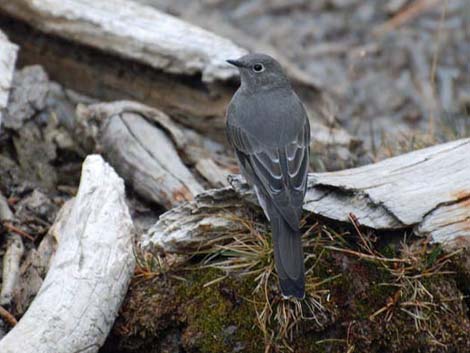 Townsend's Solitaire |
Locations Lee Canyon is located northwest of Las Vegas, on the northeast side of Mt. Charleston, about 90 minutes from downtown. Drive out to Mt. Charleston. From the turnoff on Highway 95, drive west on Highway 156. The road ends at the Lee Canyon Ski Area (Table 1, Site 0556). --Pullouts along the Road. There are a number of pullouts along the road to watch and listen for birds. Consider stopping for a few minutes to bird at the gravel depot (Site 0728) in the lower pinyon-juniper zone and the turnoff to Mack's Canyon (Site 729) in the upper pinyon-juniper zone. --Sawmill Picnic Area. The picnic area provides a nice place to stop, listen for birds, and hit the restrooms. --Long (Lee) Meadow (Site 0557). Long meadow is located on the north side of the road, about 2 miles before the end of the road. You can't miss it. |
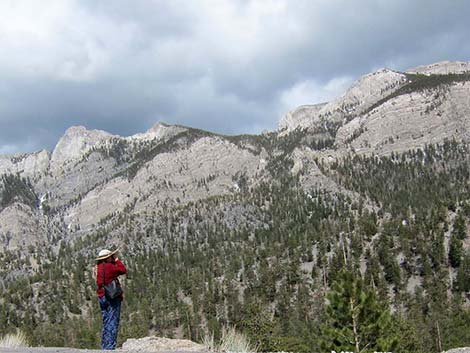 Birding the end of the road |
--End of the Road (Upper Bristlecone Trailhead) (Site 0556). The pavement ends at an overlook above Lee Canyon (far end of the ski area parking lot). --Lower Bristlecone Trailhead (Site 0550). Lower Bristlecone Trailhead is located about 1 mile before the end of the road. Watch for a trailhead sign past Long Meadow and before McWilliams Campground. Drive about 100 yards to the big dirt parking lot at the end of the road. --Upper Bristlecone Trail (Site 0556). The upper end of the Bristlecone Trail starts at the end of the paved road. |
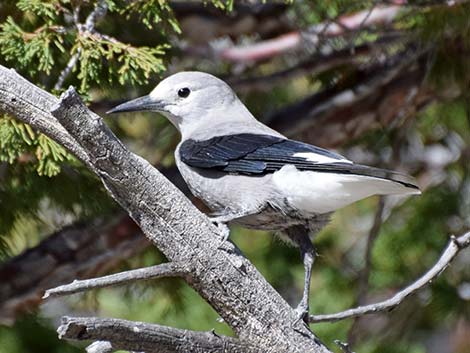 |
Hours Always open. Fees None. Specialties Lee Canyon is good for finding a variety of woodpeckers, chickadees, swallows, White-throated Swift, all three nuthatches; Black-throated Gray Warbler, Townsend's Warbler, MacGillivray's Warbler, Virginia Warbler, and Wilson's Warbler, Mountain Bluebird, Western Bluebird, Steller's Jay, Clark's Nutcracker, and other montane species. Williamson's Sapsuckers nest in dead trees at the top of the Bristlecone Trail. |
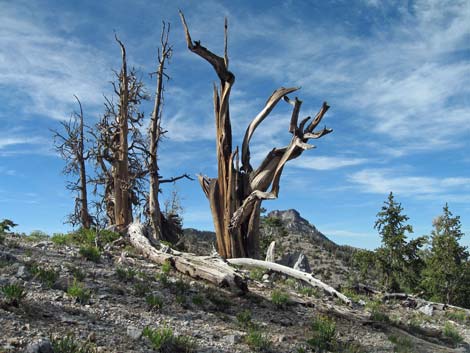 High ridge along the Bristlecone Trail |
Bird Species I've Seen in Lee Canyon: Red-tailed Hawk, American Kestrel, Broad-tailed Hummingbird, Rufous Hummingbird, Williamson's Sapsucker, Hairy Woodpecker, Northern Flicker, Gray Flycatcher, Cordilleran Flycatcher, Say's Phoebe, Woodhouse's Scrub-Jay, Clark's Nutcracker, Common Raven, Violet-green Swallow, Mountain Chickadee, Red-breasted Nuthatch, White-breasted Nuthatch, Pygmy Nuthatch, Brown Creeper, Western Bluebird, Mountain Bluebird, Hermit Thrush, American Robin, Black-throated Gray Warbler, Townsend's Warbler, MacGillivray's Warbler, Virginia Warbler, Wilson's Warbler, Yellow-rumped Warbler, Western Tanager, Green-tailed Towhee, Chipping Sparrow, Dark-eyed Junco, Black-headed Grosbeak, Purple Finch, Cassin's Finch, Red Crossbill, Townsend's Solitaire, Hermit Thrush. Other Species: feral horse, golden-mantled ground squirrel, kit fox, Mt. Charleston chipmunk, and western fence lizard. |
Table 1. GPS Coordinates for Highway Locations (NAD27; UTM Zone 11S). Download Highway GPS Waypoints (*.gpx) file.
| Site # | Location | Latitude (°N) | Longitude (°W) | UTM Easting | UTM Northing | Elevation (feet) |
|---|---|---|---|---|---|---|
| 0550 | Bristlecone Trailhead, Lower | 36.3119 | 115.6765 | 618823 | 4019150 | 8,483 |
| 0556 | Bristlecone Trailhead, Upper | 36.3065 | 115.6771 | 618772 | 4018550 | 8,684 |
| 0557 | Lee Canyon Meadow | 36.3164 | 115.6743 | 619005 | 4019660 | 8,450 |
| 0728 | Hwy 156 (Lee Canyon Rd) at gravel depot | 36.3815 | 115.6082 | 624835 | 4026965 | 6,530 |
| 0729 | Hwy 156 (Lee Canyon Rd) at Mack's Canyon Rd | 36.3496 | 115.6446 | 621625 | 4023380 | 7,480 |
Happy birding! All distances, elevations, and other facts are approximate.
![]() ; Last updated 240322
; Last updated 240322
| Birding Around Las Vegas | Southern Nevada Birds | Guide Service | Copyright, Conditions, Disclaimer | Home |